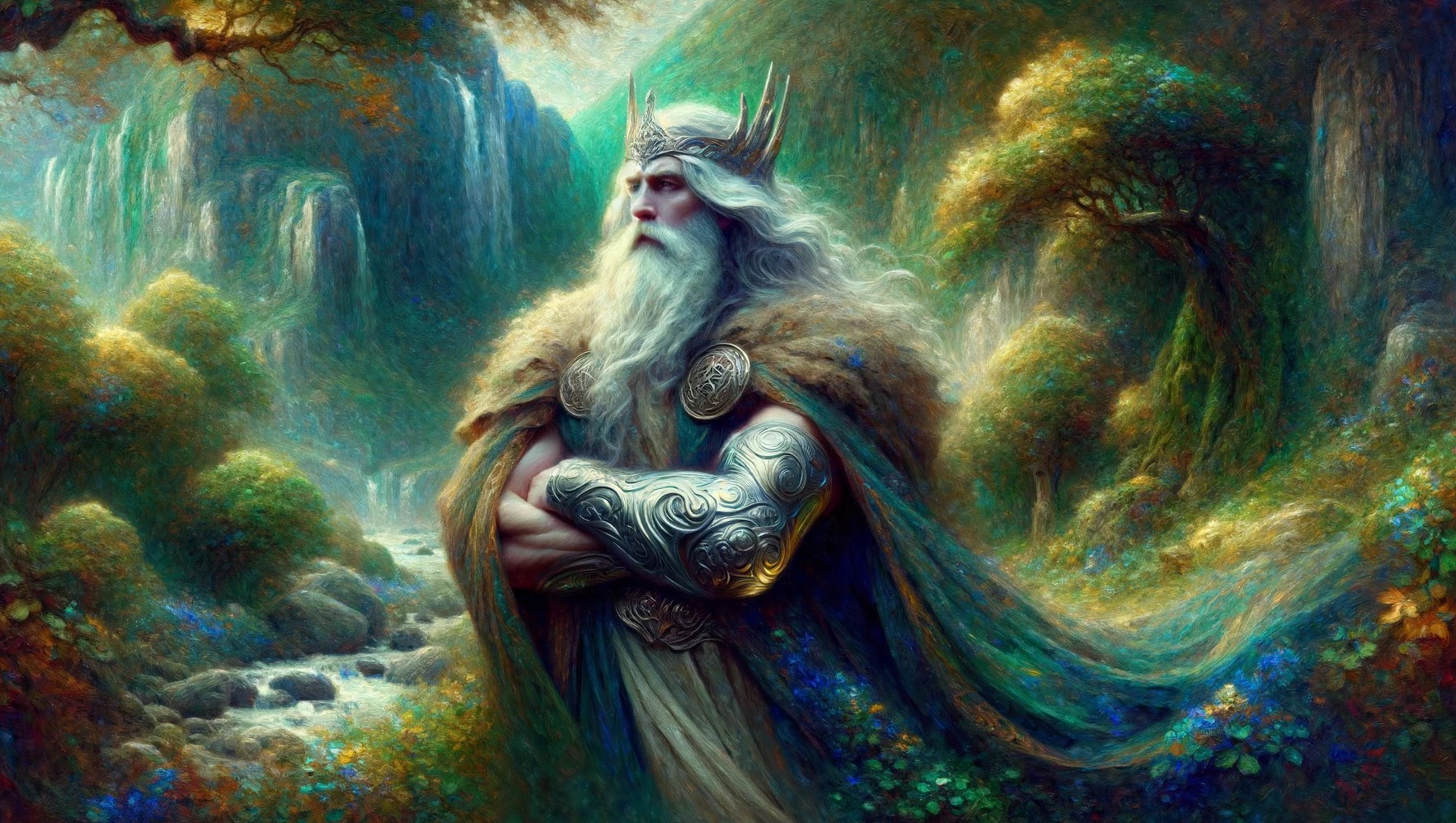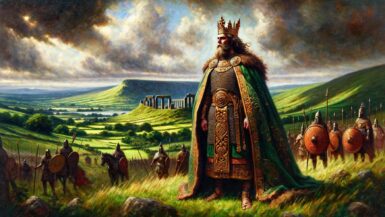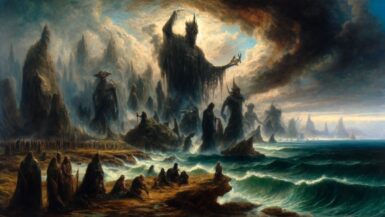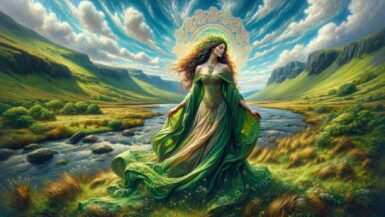In the rich tapestry of Irish mythology, few figures are as central or as emblematic as Nuada, the first king of the Tuatha Dé Danann, a mythical race of divine beings who once ruled Ireland. Known by his epithet, “Airgetlám,” translating to “Silver Hand/Arm,” Nuada’s tale is one of triumph, tragedy, and the timeless pursuit of justice and rightful leadership. His story, deeply woven into the fabric of Irish myth, reflects broader themes of resilience, restoration, and the complex interplay between physical integrity and the right to rule. Nuada’s legacy, preserved in ancient texts and oral traditions, continues to capture the imagination, offering profound insights into the values and beliefs of the ancient Irish.
Nuada in Mythology
Nuada’s preeminence in Irish mythology is underscored by his role as the leader of the Tuatha Dé Danann during their arrival in Ireland. His wisdom, skill in battle, and fair rule endeared him to his people, marking the beginning of a golden era. However, the turning point in Nuada’s reign came during the First Battle of Mag Tuired, a decisive conflict against the Fir Bolg, the inhabitants of Ireland at the time. In this fierce encounter, Nuada lost his arm, a physical blemish that, according to the societal norms and laws of the Tuatha Dé Danann, rendered him ineligible to be king. This loss was not just physical but deeply symbolic, challenging the very essence of what it meant to lead.
The significance of Nuada’s silver arm extends beyond the miraculous craftsmanship of Dian Cécht, the god of healing, and his son, Miach. It represents a profound meditation on leadership, wholeness, and the capacity for renewal. The replacement of his arm with one of silver, and subsequently, a flesh and blood arm, allowing him to reclaim his throne, speaks to the ancient Irish values of resilience, restoration, and the reintegration of the physically marred leader back into the social and mythic fabric of the Tuatha Dé Danann. This act of healing and restoration was not merely physical but symbolized the societal acceptance of Nuada’s renewed capacity to lead, challenging and ultimately transforming the norms around kingship and physical integrity.
The Tuatha Dé Danann and the Battles of Mag Tuired
Overview of the Tuatha Dé Danann, Their Origins, and Their Significance
The Tuatha Dé Danann, often depicted as a race of divine beings or gods, are central to Irish mythology. They are said to have descended from the goddess Danu, embodying the quintessence of Irish pagan worship. The mythology portrays them as skilled in ancient druidry, arts, and sciences, which they used to enchant the island of Ireland, transforming it into a land of magic and mystery. Their arrival in Ireland is marked by a series of mythical tales that highlight their supernatural abilities and their desire to claim Ireland as their own, establishing a dominion characterized by prosperity and wisdom.
The First Battle of Mag Tuired: Nuada’s Loss of His Arm and the Implications for His Rule
The First Battle of Mag Tuired was a pivotal event that showcased the Tuatha Dé Danann’s struggle to assert their supremacy over the indigenous Fir Bolg. Nuada, leading his people with valor and strength, was not only a king but also a warrior of great renown. However, the battle took a personal toll on him when he lost his arm, an event that had profound implications for his kingship. According to the ancient laws governing the Tuatha Dé Danann, a king had to be physically unblemished. Nuada’s injury, therefore, rendered him ineligible to rule, reflecting the societal values and cultural norms of the time which equated physical wholeness with the capacity for leadership and sovereignty. This loss symbolized not only a personal tragedy for Nuada but also a societal disruption, as it challenged the prevailing standards of leadership and perfection.
The Second Battle of Mag Tuired: Nuada’s Strategic Leadership and the Eventual Victory over the Fomorians
Following the restoration of his arm through the magical craftsmanship of Dian Cécht and the wondrous healing of his son Miach, which replaced the silver prosthesis with flesh and blood, Nuada was reinstated as king. His leadership was soon put to the test in the Second Battle of Mag Tuired, this time against the formidable Fomorians, a race of demonic beings threatening the prosperity and freedom of the Tuatha Dé Danann’s realm. In this battle, Nuada’s strategic acumen shone brightly. His ability to unite and inspire his people, along with the acceptance of new and powerful allies like Lugh, showcased a king who was not only a warrior but a visionary leader. Under his guidance, the Tuatha Dé Danann achieved a decisive victory, marking a turning point in the mythical history of Ireland. This triumph not only secured the sovereignty of the Tuatha Dé Danann over Ireland but also symbolized the overcoming of adversity through unity, wisdom, and the strategic exercise of power.
The Symbolism of the Silver Hand
Nuada’s silver arm, beyond its physical representation, carries deep symbolic weight within Irish mythology. Crafted by Dian Cécht, the healer of the gods, and later replaced with flesh and blood by his son Miach, the silver limb represents more than a marvel of mythical medicine; it symbolizes the intersection of loss, innovation, and the integration of human imperfection with divine providence. This silver arm stands as a testament to the resilience of the spirit, the advancements of craftsmanship and magic, and the adaptability in the face of irreversible change. It also reflects the early Irish society’s reverence for skill and ingenuity, as well as their complex relationship with the concept of physical and moral integrity.
Physical Wholeness in Ancient Irish Kingship
In ancient Irish society, as depicted in the legends of the Tuatha Dé Danann, the king was not merely a ruler but an embodiment of the land’s health and prosperity. The physical wholeness of the king was symbolically linked to the wholeness of the kingdom he ruled. Thus, Nuada’s loss of his arm and subsequent disqualification from kingship reflect a profound societal belief in the physical perfection required of a leader. This belief underscores the perceived connection between the physical body and the moral and spiritual capability to govern. The restoration of Nuada’s arm, first with silver and then with flesh, symbolizes not only the restoration of his personal sovereignty but also a restoration of societal order and the reaffirmation of the link between leadership and the land’s vitality.
Loss, Restoration, and Resilience
Nuada’s story is a powerful narrative on the themes of loss, restoration, and resilience. The loss of his arm represents a profound personal and societal crisis, challenging existing norms around leadership and perfection. The creation of the silver arm and its later replacement with one of flesh and blood signify the possibility of overcoming loss and the capacity for healing and renewal. These acts of restoration illustrate the resilience of the Tuatha Dé Danann and their king, emphasizing the idea that wholeness can be achieved through transformation and the acceptance of change.
Moreover, Nuada’s journey from loss through restoration to eventual triumph encapsulates the human experience of overcoming adversity through resilience, innovation, and the support of the community. It reminds us that perfection is not a static state but a process of continuous adaptation and renewal. Through the symbolism of the silver hand, the myth conveys enduring lessons on the power of resilience, the importance of adaptive leadership, and the indomitable spirit required to face life’s inevitable challenges and transformations.
Nuada’s Legacy and Influence
Nuada’s Impact on Later Irish Kingship and Mythology
Nuada’s reign as the king of the Tuatha Dé Danann set a precedent for the qualities and virtues expected of leaders in Irish mythology and, by extension, in the cultural memory of Ireland. His story, particularly the trials surrounding his kingship, loss, and restoration, deeply influenced the conceptual framework of leadership in Irish lore. The insistence on physical and moral integrity, the significance of wise and just rule, and the resilience in the face of adversity became benchmarks for evaluating kings and leaders in subsequent myths and tales. Nuada’s legacy is also evident in the myths of later figures who embody similar attributes of leadership, wisdom, and the capacity to unify and protect their people. His story has been a source of inspiration for narratives around kingship, sovereignty, and the heroic journey, echoing through the ages in the rich tapestry of Celtic mythology.
Nuada in Modern Ireland
In modern Ireland, Nuada’s legacy transcends the realm of ancient mythology, permeating various aspects of cultural identity, literature, and the arts. He symbolizes the enduring qualities of leadership, resilience, and the pursuit of justice, resonating with contemporary values and the national ethos. Nuada’s story, particularly his embodiment of resilience and adaptability, speaks to the historical and ongoing narratives of survival and reinvention that characterize the Irish experience, both domestically and in the diaspora. This ancient king’s journey of overcoming physical loss and reclaiming his rightful place through wisdom and strategic prowess continues to inspire modern narratives around overcoming adversity, making him a figure of cultural significance and national pride.
Locations Named After Nuada, Such as Maynooth (Maigh Nuad)
Nuada’s name and legacy are immortalized in the geography of Ireland, most notably in the town of Maynooth, County Kildare. The name Maynooth, or “Maigh Nuad” in Irish, translates to “the plain of Nuada,” signifying the area’s connection to this mythological king. This naming is a testament to the lasting influence of Nuada’s myth on the Irish landscape and its cultural heritage. Maynooth, with its historical significance and as the site of Maynooth University, serves as a living monument to Nuada’s enduring legacy, reflecting the blend of ancient mythology with the contemporary pulse of Irish life. The presence of Nuada in the names and stories of places across Ireland keeps the myth alive, reminding the Irish people and their visitors of the deep roots and complex layers of their cultural identity, shaped by tales of heroism, leadership, and resilience.
Nuada’s Relationships and Family
Nuada’s Familial Connections, Including His Relationship with Boann
Nuada, a central figure in Irish mythology, is intricately connected with a pantheon of deities, embodying the rich tapestry of familial and relational dynamics characteristic of Celtic myth. Notably, his relationship with Boann, the goddess of the River Boyne, adds a layer of depth to his character. Boann, in some accounts, is mentioned in relation to Nuada, suggesting a union that bridges the powerful elements of water and sovereignty. This connection underscores the interdependence and harmony between different aspects of the natural and divine world within Irish mythology.
His Association with Other Deities and Mythical Figures, Like Dian Cécht and Lugh
Nuada’s interactions with other deities highlight the communal and interconnected nature of the Tuatha Dé Danann. His relationship with Dian Cécht, the god of healing, is particularly significant. Dian Cécht’s creation of the silver arm for Nuada not only restored his physical form but also symbolized the healing powers of the deities and their capacity for technological wonders and magical healing. Furthermore, Nuada’s acceptance and promotion of Lugh, a figure of youth and versatility, into the Tuatha Dé Danann, illustrates Nuada’s wisdom and foresight in recognizing and nurturing talent for the greater good of his people.
Comparisons to Other Mythologies
Nuada in the Context of Similar Deities in Celtic and Other Indo-European Mythologies
Nuada’s narrative shares thematic and symbolic parallels with deities across Celtic and Indo-European mythologies, indicating a widespread motif of loss, restoration, and leadership. Nodens, a deity from British mythology associated with healing, the sea, and hunting, bears resemblance to Nuada, particularly in their shared symbolism of physical loss and restoration. Both figures are seen as leaders and healers, embodying sovereignty and the regenerative power of nature and magic.
Nuada’s Parallels with Figures Like Nodens, Lludd Llaw Eraint, and Others
Further parallels can be drawn with Lludd Llaw Eraint (Lludd of the Silver Hand), a figure in Welsh mythology. Like Nuada, Lludd is associated with leadership and healing, his silver hand symbolizing similar themes of loss, technological or magical restoration, and the reclamation of power. These cross-cultural motifs underscore the universal themes of resilience, the integration of loss into one’s identity, and the transformative potential of adversity.
These comparative insights reveal the broader Indo-European mythological tradition of intertwining themes of sovereignty, physical integrity, and the cyclical nature of loss and renewal. Nuada’s story, alongside those of Nodens and Lludd, reflects a deep-rooted human fascination with the capabilities and resilience of leaders who navigate the delicate balance between vulnerability and strength, underscoring the timeless relevance of these myths in understanding the human condition.
Nuada in Popular Culture
Nuada’s Appearances in Modern Media, Including Literature, Film, and Video Games
Nuada, with his rich mythological background and intriguing persona, has found his way into various forms of modern media, from literature and film to video games. His story, particularly the iconic imagery of his silver arm, has captivated audiences and creators, leading to nuanced interpretations of his character. In literature, Nuada often appears in fantasy novels that draw upon Celtic myths, portrayed as a wise king who overcomes adversity through resilience and wisdom. Films, such as “Hellboy II: The Golden Army,” reinterpret Nuada as a complex antagonist, highlighting themes of environmental protection and the clash between the ancient and the modern world. Video games, too, have incorporated Nuada, presenting him as a character who combines elements of magic and martial prowess, appealing to players fascinated by mythology and heroism.
How These Adaptations Interpret and Reimagine His Mythology
These cultural adaptations of Nuada’s mythology reflect the enduring fascination with and relevance of ancient myths in contemporary society. They often emphasize Nuada’s resilience, strategic thinking, and the quest for justice, attributes that resonate with modern audiences. These reinterpretations also offer new perspectives on Nuada’s story, exploring themes such as the consequences of technological advancement (symbolized by his silver arm), the complexities of leadership, and the negotiation between tradition and change. By reimagining Nuada’s mythology, modern adaptations contribute to the ongoing dialogue between the past and the present, inviting audiences to reflect on the timeless human experiences encoded in myth.
Conclusion
Nuada’s Enduring Legacy in Irish Mythology
Nuada’s legacy in Irish mythology is profound and multifaceted. As the king of the Tuatha Dé Danann, his narrative from loss to restoration embodies themes of resilience, leadership, and the transformative power of healing. Nuada’s journey through adversity, culminating in the reclamation of his kingship and the prosperity of his people, continues to inspire and captivate the imagination. His silver arm, beyond its immediate mythical context, symbolizes the broader human capacity for adaptation, innovation, and the restoration of wholeness in the face of fragmentation.
The Importance of Mythological Figures Like Nuada in Understanding Cultural Values and History
Nuada, like other mythological figures, serves as a window into the cultural values, spiritual beliefs, and historical perceptions of ancient societies. Through the lens of Nuada’s stories, we gain insight into the Celtic world’s reverence for harmony between the physical and spiritual realms, the valorization of wise and equitable leadership, and the deep-seated belief in the possibility of renewal and redemption. Nuada’s enduring presence in modern culture underscores the continued relevance of these ancient narratives, reminding us that myths are not mere stories from the past but living, evolving constructs that continue to shape our understanding of the world, our values, and ourselves. Through engaging with figures like Nuada, we participate in the timeless human endeavor to make sense of our existence and to find meaning in the continuum of history and myth.






Leave a reply